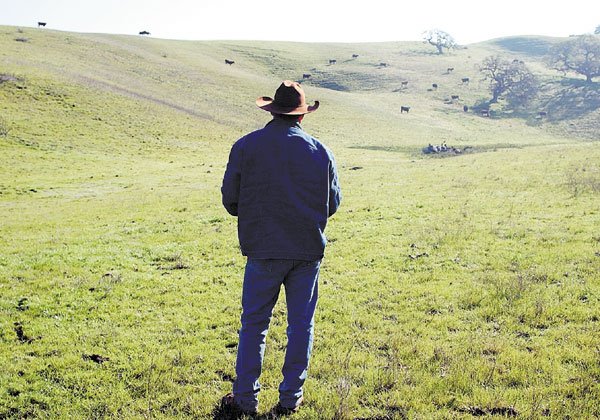Local ranchers aim to take good care of their cattle and the
land
It seems pretty basic – move your cattle around on the land to avoid overgrazing and simulate the natural state of things.
It’s what Joe and Julie Morris do to raise their grassfed beef cattle. But it’s really not so simple, and a day spent at the cutting edge of ranching is anything but basic.
A day on the T.O. Cattle Company ranch in San Juan Bautista can be spent herding the cattle, keeping them bunched together instead of letting them spread out all over the land. It can involve mending fences and repairing ranch equipment. And it can involve a lot of planning – to decide where the cattle will graze next and when, and to determine the best way to get the cattle from the rangeland to the customers. Some days also involve monitoring the land to see if it’s staying healthy.
Like many ranchers, the Morrises are interested in making sure they’re the best land stewards they can be; they just take a more holistic approach than most.
“It stems from the idea that all things are connected, economically, ecologically and socially,” said Joe Morris. “We don’t believe we can sacrifice the land to benefit economically long-term, and we don’t believe we can run a business and lose money and be sustainable.”
The Big Idea
Many of the Morrises’ practices are geared toward protecting the land, and the biggest one is the way the cattle are allowed to graze. They’re kept together in a herd to mimic the way Central Coast grasslands developed, that is, kept in check and helped along by grazing animals such as elk.
“The animals helped to maintain the plants, and the plants helped support the animals,” Morris said.
He noted that because most of the native grazers are gone, it falls to ranchers to simulate the pattern that the grasslands evolved with.
“We’ll project a plan that tells us how long the plants need to recover after they’ve been grazed, and we’ll move our herd away from those plants so they’re not overgrazed,” Morris said.
That protects not just the leaves of the eaten plant, but also its roots, helping to guarantee its survival.
How It All Began
Joe Morris is a fifth-generation California cattle rancher who decided to come back to ranching after years spent working and studying around the world.
He spent time as a student in London and as a lay missionary with the Catholic Church in Venezuela, and it was traveling and seeing much of the world that led him to the realization that things are connected. He began reading the works of others who had this philosophy.
“I began to see the connection between agriculture and the larger culture, between the U.S. and the world,” he said.
Julie and Joe decided to return to California and make a go of it in the cattle business. But not before doing the research.
“I went to people I respected and asked them what I should do. They pretty uniformly told me you could not make money in the cattle business,” Joe said.
“I concluded I either had to give up my dream of getting into the cattle business because I didn’t have any money to lose, or I’d have to do things completely differently from the people who I thought were doing it the best way.”
So Joe consulted others about how to run a business, about the production processes of cattle-raising and started to think about how those two aspects fit together on a sustainable, healthy grassland. And he started to think about pursuing a niche market. He saw grasslands that weren’t owned or leased but were managed by people with a keen interest in ecological health.
“I enjoy looking around and finding people who are thinking differently and doing things in this holistic way,” he said.
All that thought has paid off: The Morrises have about 400 head of their own cattle and manage about 2,500 head of cattle for others. They move the cattle around 7,000 acres of grassland on six different ranches within a 45-mile diameter on the Central Coast. The Morrises raise red and black angus and red Devon cattle.
“In our case, we’re pretty fortunate. We have wonderful grasses on the Central Coast; they’re really sweet grasses. The taste of the beef is sweet and rich,” Joe said. “It’s like wine from different regions on different soils will taste differently. That’s a good thing in our mind.”
The Response
The Morris’ operation has proved popular among customers looking for good-tasting beef and those looking for healthy, sustainable land stewardship.
In fact, the Morrises’ business model has become something of a teaching tool. In the last 15 years, the Joe Morris has talked to thousands of people, he estimates, about what they’re doing, and many of those have been biologists and environmentalists looking to learn more about ranching and sustainability.
Kim Hayes, land manager for the Elkhorn Slough Foundation, says that because of Morris’ approach, their grassland is some of the healthiest in the area. The Morrises lease some land from the foundation for grazing.
“It’s a very positive relationship with natural resource management,” she said. “He does very responsible and attentive cattle ranching. The cattle never overgraze in an area.”
For customers, too, the approach to ranching is important.
“We eat it because it tastes better, and we think it’s healthier,” said Dave Singleton, a Hollister resident and customer of Morris’ for more than five years. “It’s part of living healthily and feeling a connection with the land. We love to look up at the hills, and if the hills aren’t going to be developed, they still need to be productive.”
Beyond Organic
The Morrises are frequently asked if their beef is organic. It’s not certified organic, but many of the processes that they follow, such as removing an ill animal from the herd and not giving the animals hormones or antibiotics, are in keeping with government standards for organic beef.
But the Morrises go farther in their herd management. The animals are never put into feedlots, and their handlers strive to prevent problems by using good nutrition, low stress and a clean environment.
Their concern is not just for the animals, but for the land as well, so they monitor its health each year, checking to see what’s growing, if there’s diverse plant life, if there is evidence of insects, spiders, earthworms, if there has been any erosion and more.
There are always conflicting views on how to manage anything, and ranchlands are no different.
“There’s a big divide between the scientists and people putting together regulations to regulate grasslands and the ranchers who are trying to manage grasslands,” Morris said.
Coming to an understanding depends not on what’s happening in a conference room, but out on the land.
“People can read books and talk until they’re blue in the face, and they’ll never budge from their original position. We can deceive ourselves. If you get out on the land, it’s much harder to do that,” Morris said. “The plants and animals are entirely vulnerable and entirely honest.”
The Future of Ranching
So Joe Morris’ day, aimed at preserving the future of his business and the land he works, is also a day closer to preserving a way of life.
Many lament the passing of ranching and the cowboy way of life, but Morris has looked to history in order to preserve it.
“We use the arts of the vaquero – horses and dogs – to do our work, using our heritage to inform our present use of the rangeland,” he said. “Long-term, I think ranchers are going to be in a very good position. When they say it’s dying out, I think it’s one of those things that’s going to have to get worse before it gets better.”
Joe Morris’ day isn’t just about the cattle. There’s getting the kids to school, taking vacations now and then and enjoying the view. And then there’s learning more, always more, from other ranchers, scientists, customers, books.
“But mostly,” Joe said, “we have to learn from the plants and animals.”
T.O. Cattle Company practices
Here are some practices the Morrises use in their holistic approach to ranching:
– Herding: Keep cattle bunched together in a herd to prevent overgrazing and work with the way the grasslands evolved.
– Vaquero style: use horses and dogs to herd the cattle, as vaqueros did when this was known as Alta California.
– Monitoring: Examine the soil surfaces at certain areas throughout the rangeland to make sure it remains healthy.
How to Order
What’s available: Most opt for a “split half” which is half of a front quarter and half a hindquarter. It amounts to about 80 pounds of beef. Also available is a family pack, about 60 pounds; a half, about 160 pounds; and a whole, about 320 pounds. It’s a lot of meat, but it comes frozen, ready to throw into your freezer for use all year long.
Where it’s available: At the farmer’s market in Hollister. Orders are also taken from the Web site (www.morrisgrassfed.com) or through the e-mail newsletter.
How it works: Order the amount you want, and you get put on a list, grouped according to the animal. When the animal goes to harvest, you receive an e-mail saying your beef will be ready for pickup in three weeks. Some delivery is also available.
How to reach T.O. Cattle Company: (831) 623-2933; in**@************ed.com; 500 Mission Vineyard Road, San Juan Bautista, Calif. 95045.













